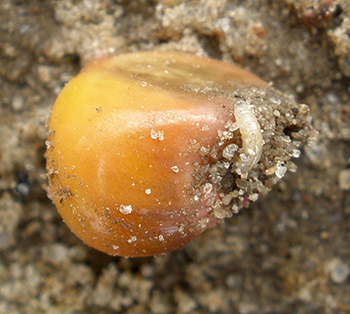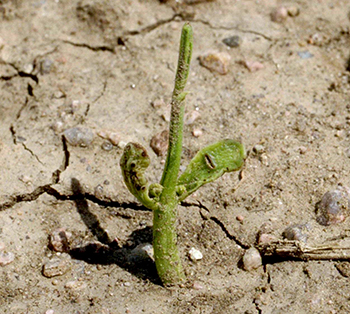Profile of a planting-time pest: Seedcorn maggot in vegetables
Prepare at planting time to avoid maggot pests in vegetables.

Appearance and life cycle
Seedcorn maggots overwinter as a brown, wheat-seed size pupa 3-6 inches below the soil surface. Overwintered flies emerge in the spring during April and May. The housefly-like adults can be seen flying low over newly worked soil. Females prefer to lay eggs in freshly turned soil with decaying organic matter. Sites where cover crops or green manure were recently incorporated or manure was spread are highly attractive. (View pdf factsheet on seedcorn maggot)
Eggs hatch into tiny, white, wedge-shaped, 0.25-inch long maggots with no noticeable head or legs. Larvae shed their skin three times as they feed on decaying organic matter and seeds/seedlings before pupating. A next generation of flies emerges from these pupae. Development from egg to adult requires roughly 376 growing degree days (GDD) base 39 degrees Fahrenheit.
There are likely three generations per year in Michigan. Starting in August, offspring of the later generations may pupate and enter diapause (overwintering stage). These pupae overwinter and flies emerge from them the following spring. The offspring of this spring generation of flies is typically the most damaging.
Damage
This pest is typically detected by the damage it causes when maggots feed underground on seeds before and when they germinate. In beans, the effects of underground feeding are visible once plants emerge and include holes in the first true leaves, dark areas on the cotyledons, and in severe cases a “snake-head” symptom when the growing point is completely destroyed and seedlings emerge leafless. Stand reduction in beans may be less common than in other crops, but damaged plants may be slow to develop and produce few beans.
Unlike beans, damage in peas, sweet corn and vine crops is typically not visible above ground, and is noticed as a stand reduction. Dig up seeds where there is a gap in the stand and split them open to look for maggots and tunnels. Maggot tunneling in vine crop seeds is harder to detect. Damage can sometimes be detected on emerging vine crop seedlings as light feeding along the edges of cotyledons, or their complete destruction. Damage in onions and cole crops is noticeable when seedlings wilt or die from below-ground damage.


Left, Seedcorn maggot larvae tunnel in corn seeds, causing stand loss. Digging up ungerminated seeds is the best way to detect maggot damage in corn and peas. Right, In beans, maggots may completely remove leaves and the shoot growing point before emergence. Photo credits: Left photo, Mariusz Sobieski, Bugwood.org; Right photo, Howard F. Schwartz, Colorado State University, Bugwood.org.
Similar species
The bean seed maggot is very similar to seedcorn maggot in appearance and biology, and so is managed along with seedcorn maggot. In onions, onion maggots – which only attacks plants in the onion family – cause very similar damage and is a consistent problem if not controlled. Similarly, cabbage maggots are a root-feeding pest of cole crops. It is difficult to distinguish life stages of these species without a microscope.
Wireworms, the larvae of click beetles, are another seed- and root-feeding pest, but are larger and leathery brown. Stand reduction from soilborne pathogens can also be confused with seedcorn maggot damage as it often occurs under the same conditions (cool, wet planting seasons).
Management
Seedcorn maggot is a sporadic pest that is typically only a problem when planting time lines up with conditions that are attractive to egglaying flies and poor for crop growth. Cultural controls involve timing field operations to avoid these conditions. The following tactics can be used singly or in combination to reduce your risk on your farm.
Avoid making fields attractive to egg-laying flies near to planting time:
- Spread manure the previous fall.
- Herbicide-kill cover crops before incorporation.
- Delay planting for two and a half to three weeks after incorporating vegetation such as cover crops.
Avoid planting during peak egglaying or when these hatching larvae will be feeding:
- Use the seedcorn maggot MSU Enviro-weather model to estimate peak emergence and avoid planting then.
- If possible, wait approximately 376 GDD base 39 F (about two to three weeks) after the predicted peak emergence. At this time, larvae from eggs laid during peak should be reaching the non-damaging pupal stage,
Plant when environmental conditions favor rapid seedling emergence:
- Delay planting until maximum soil temperatures at 4 inches are consistently above 70 F, which will speed crop emergence and potentially make soils less attractive to flies.
- Avoid planting into very wet soils.
If high-risk planting situations cannot be avoided, seed treatments or soil insecticide applications can protect your plants. See Michigan State University Extension Bulletin E-312, “2015 Insect, Disease and Nematode Control for Commercial Vegetables,” for options.



 Print
Print Email
Email




